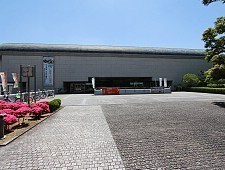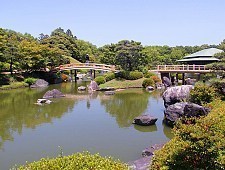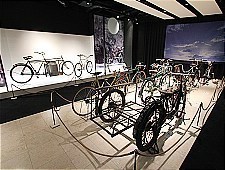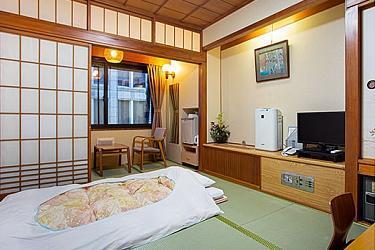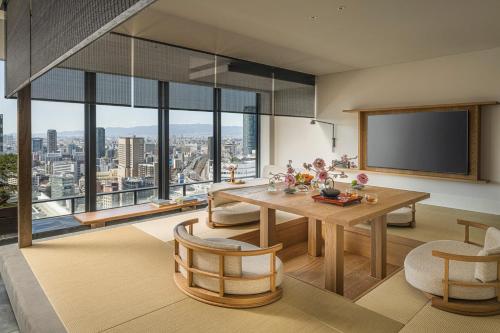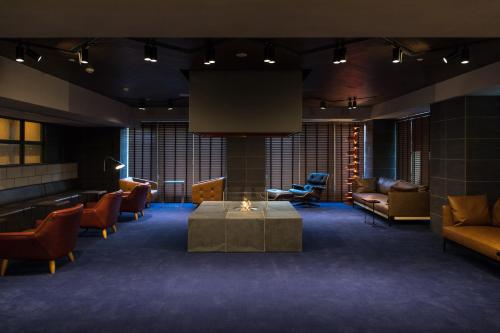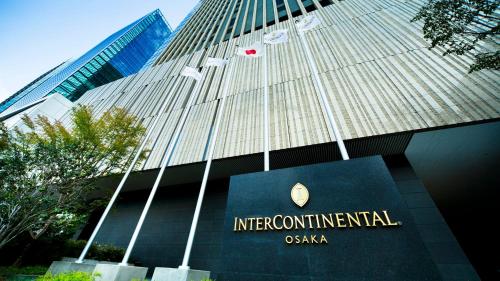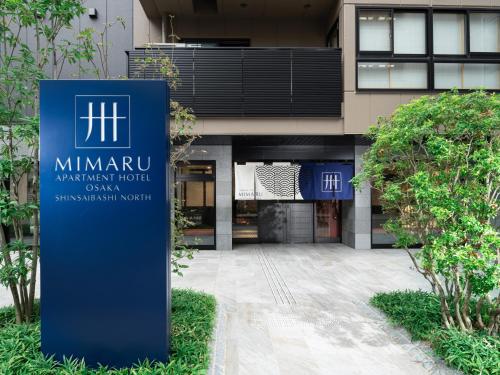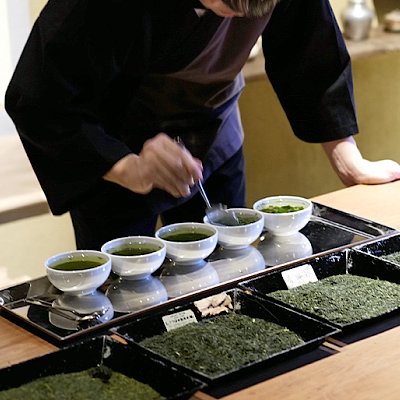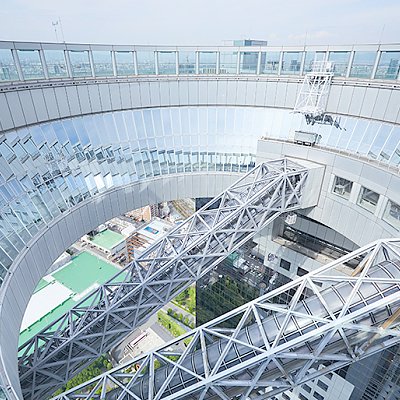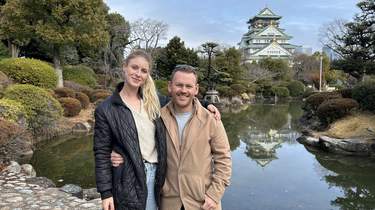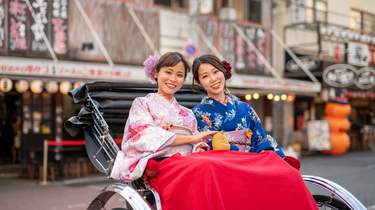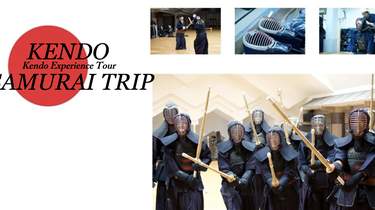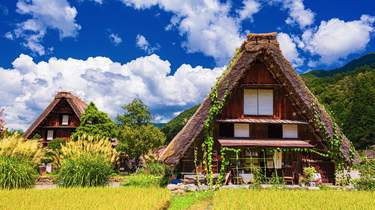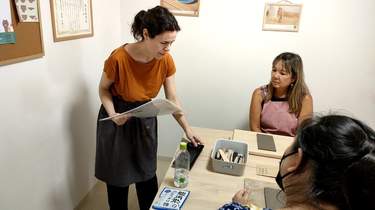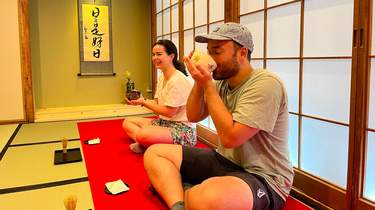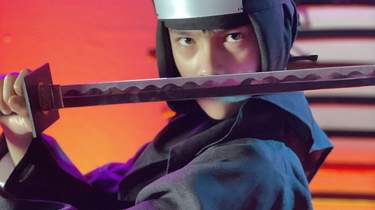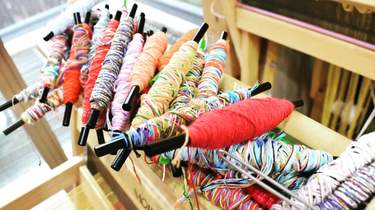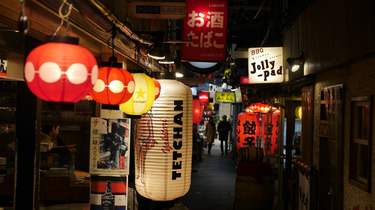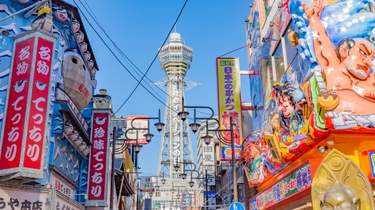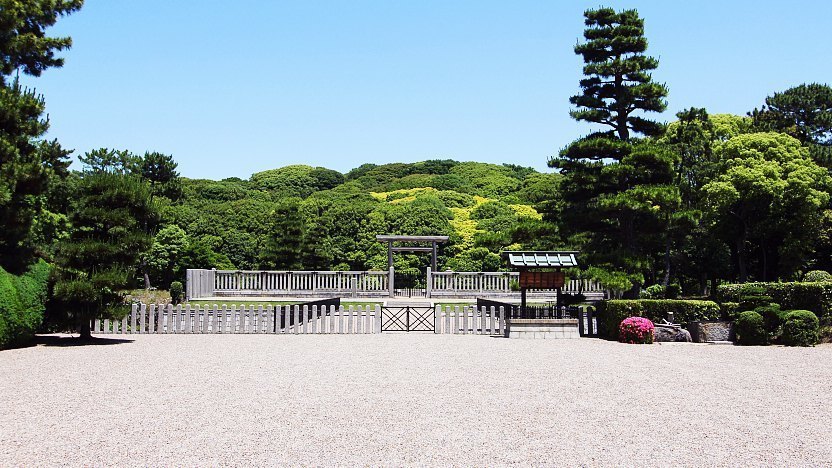
The Mozu Tombs (Sã¹ÃQ, Mozu Kofungun) are a cluster of several dozen ancient tombs in the Mozu area of Sakai City, immediately south of Osaka City. The cluster, along with some other tombs in the region, makes up the "Mozu-Furuichi Kofungun Ancient Tumulus Structures", which were designated a Cultural World Heritage Site in 2019.
The tombs were built in the 4th to 6th centuries for the ruling elite, with the larger, more elaborately shaped mounds signifying higher status than smaller amd simpler ones. The largest of the tombs is the Emperor Nintoku Kofun which is believed to be the tomb of Emperor Nintoku. With the surrounding moats included, the tomb is about 800 meters long and 600 meters wide, making it not only Japan's largest grave, but also one of the world's largest. Less than a kilometer away lies the Emperor Richu Kofun, the third largest tomb in Japan.
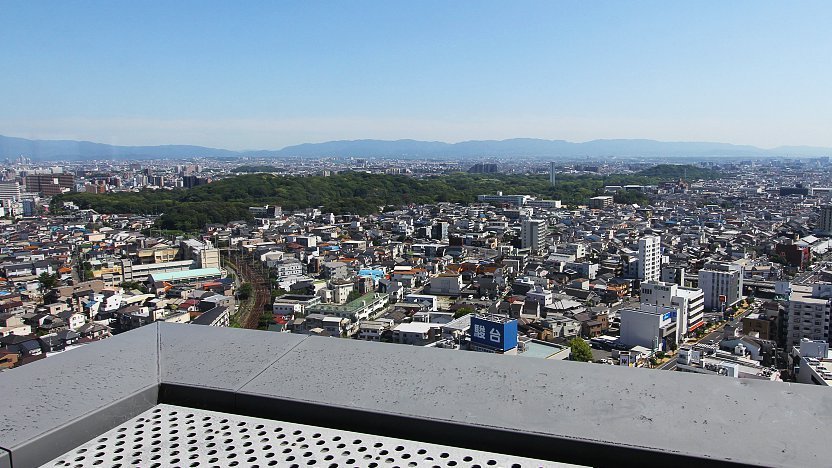
Kofun tombs are large mounds of earth. Originally kept relatively free of vegetation, today most of them are covered by trees. Many of the larger tombs, including the ones of Emperor Nintoku and Emperor Richu, are of a keyhole shape and surrounded by moats. The tombs are generally not open to the public, and the larger ones are difficult to fully appreciate unless viewed from a high vantage point. The free observation deck on the 21st floor of the Sakai City Hall allows for such views from about a kilometer away.
A large number of medium and small sized kofun tombs are spread across the spacious and pleasant Daisen Park which stretches between the kofun of Emperor Nintoku and Emperor Richu. Balloon rides are from this park, giving participants a birdfs-eye view of the vast tombs that are otherwise difficult to fully appreciate. The park also offers a few attractions that are not directly related to the tombs:
Getting there and around
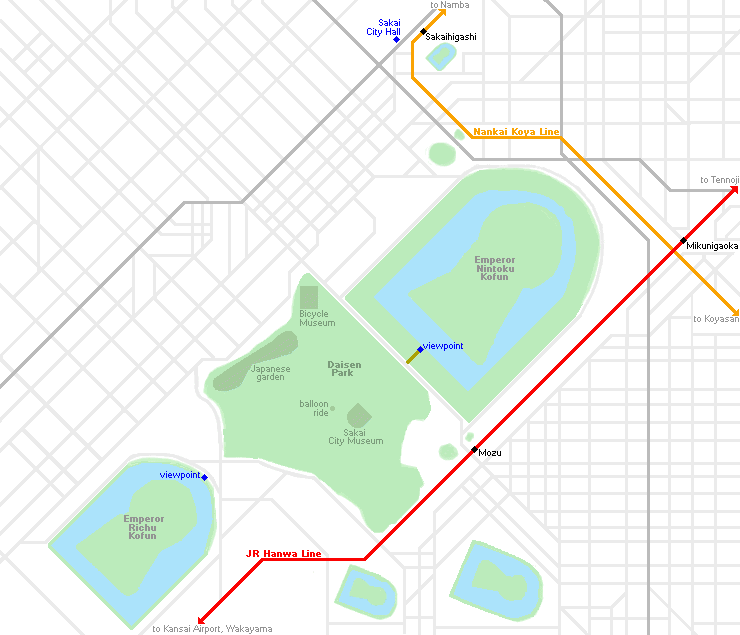
The Mozu Tombs and the surrounding attractions are most easily accessed from Mozu Station along the JR Hanwa Line. From Tennoji, take a rapid train to Sakaishi (7 minutes) and transfer to a local train to Mozu (4 minutes). The one way journey costs 240 yen and is covered by the Japan Rail Pass and other JR passes. Daisen Park is a short walk from the station.
The other station of interest is Sakaihigashi Station along the Nankai Koya Line which lies next to the Sakai City Hall and a 20-30 minute walk from Daisen Park. The one way ride from Namba Station to Sakaihigashi takes about 15 minutes and costs 290 yen by express trains. It is not covered by JR passes.
Hours and Fees
Daisen Park
Hours
Closed
Admission
Balloon rides
Hours
Closed
Admission
Sakai City Hall Observatory
Hours
Closed
Admission
Questions? Ask in our forum.
Links and Resources
English
Hotels around Osaka
-
-
![]() SponsoredKaneyoshi RyokanA modern Japanese inn in Dotombori. the center of Osaka. 2 subway stations nearby. Close to many shops and Osaka Castle.View siteSponsored
SponsoredKaneyoshi RyokanA modern Japanese inn in Dotombori. the center of Osaka. 2 subway stations nearby. Close to many shops and Osaka Castle.View siteSponsored
-
-
-
![]() Hotel 88 ShinsaibashiHotel 88 Shinsaibashi is an 8-minute walk from OCAT (Osaka City Air Terminal) and a 10-minute walk from Namba Station. Glico Man Sign is a 4-minute walk from the property. Free WiFi is available in all rooms. Featuring modern d?cor, all rooms come with air conditioning and heating facilities, a flat-screen TV and pajamas. Private bathroom includes a bath, walk-in shower, hairdryer, toilet with an electronic bidet and free toiletries. Free luggage storage is available at the 24-hour front desk. Guests can enjoy billiards at the property. There is a drinks vending machine, and laundry service can be arranged. Tsutenkaku and Shinsekai shopping street are a 16-minute train ride away. Osaka Itami Airport is a 45-minute drive from Hotel 88 Shinsaibashi.View on Booking.com
Hotel 88 ShinsaibashiHotel 88 Shinsaibashi is an 8-minute walk from OCAT (Osaka City Air Terminal) and a 10-minute walk from Namba Station. Glico Man Sign is a 4-minute walk from the property. Free WiFi is available in all rooms. Featuring modern d?cor, all rooms come with air conditioning and heating facilities, a flat-screen TV and pajamas. Private bathroom includes a bath, walk-in shower, hairdryer, toilet with an electronic bidet and free toiletries. Free luggage storage is available at the 24-hour front desk. Guests can enjoy billiards at the property. There is a drinks vending machine, and laundry service can be arranged. Tsutenkaku and Shinsekai shopping street are a 16-minute train ride away. Osaka Itami Airport is a 45-minute drive from Hotel 88 Shinsaibashi.View on Booking.com -
![]() Four Seasons Hotel OsakaSituated in Osaka and with Dojima Yakushido reachable within 500 metres, Four Seasons Hotel Osaka features concierge services, non-smoking rooms, a terrace, free WiFi throughout the property and a bar. Featuring a restaurant, the property also has a fitness centre, as well as an indoor pool and a sauna. The accommodation offers room service, a 24-hour front desk and currency exchange for guests. The rooms at the hotel come with air conditioning, a seating area, a flat-screen TV with satellite channels, a safety deposit box and a private bathroom with a bidet, free toiletries and a hairdryer. The units in Four Seasons Hotel Osaka are fitted with a coffee machine and an iPad. A buffet, ? la carte or continental breakfast is available at the property. The accommodation offers 5-star accommodation with a hot tub. Popular points of interest near Four Seasons Hotel Osaka include Herbis Plaza ENT, Octopus Pine and Herbis Plaza. Itami Airport is 16 km from the property, and the property offers a paid airport shuttle service.View on Booking.com
Four Seasons Hotel OsakaSituated in Osaka and with Dojima Yakushido reachable within 500 metres, Four Seasons Hotel Osaka features concierge services, non-smoking rooms, a terrace, free WiFi throughout the property and a bar. Featuring a restaurant, the property also has a fitness centre, as well as an indoor pool and a sauna. The accommodation offers room service, a 24-hour front desk and currency exchange for guests. The rooms at the hotel come with air conditioning, a seating area, a flat-screen TV with satellite channels, a safety deposit box and a private bathroom with a bidet, free toiletries and a hairdryer. The units in Four Seasons Hotel Osaka are fitted with a coffee machine and an iPad. A buffet, ? la carte or continental breakfast is available at the property. The accommodation offers 5-star accommodation with a hot tub. Popular points of interest near Four Seasons Hotel Osaka include Herbis Plaza ENT, Octopus Pine and Herbis Plaza. Itami Airport is 16 km from the property, and the property offers a paid airport shuttle service.View on Booking.com -
![]() 30 PIECES Namba30 PIECES Namba provides accommodation within 200 metres of the centre of Osaka, with free WiFi, and a kitchen with a microwave, a toaster and a fridge. This 4-star aparthotel offers a lift and full-day security. The aparthotel features family rooms. The units in the aparthotel are equipped with a kettle. All units are complete with a private bathroom and air conditioning, and certain rooms include a terrace. At the aparthotel, every unit has bed linen and towels. Popular points of interest near the aparthotel include Naniwa Park, Motomachinaka Park and Namba Station. Itami Airport is 20 km away.View on Booking.com
30 PIECES Namba30 PIECES Namba provides accommodation within 200 metres of the centre of Osaka, with free WiFi, and a kitchen with a microwave, a toaster and a fridge. This 4-star aparthotel offers a lift and full-day security. The aparthotel features family rooms. The units in the aparthotel are equipped with a kettle. All units are complete with a private bathroom and air conditioning, and certain rooms include a terrace. At the aparthotel, every unit has bed linen and towels. Popular points of interest near the aparthotel include Naniwa Park, Motomachinaka Park and Namba Station. Itami Airport is 20 km away.View on Booking.com -
![]() Patina OsakaSet in Osaka, 500 metres from Tamatsukuri Catholic Church, Patina Osaka offers accommodation with a garden, private parking, a terrace and a bar. Offering a restaurant, the property also has a fitness centre, as well as an indoor pool and a sauna. The accommodation provides room service, a 24-hour front desk and currency exchange for guests. Buffet and ? la carte breakfast options are available at the hotel. Patina Osaka offers 5-star accommodation with a hot tub. Popular points of interest near the accommodation include Naniwanomiyaato Park, Tamatsukuri Inari Shrine and Osaka Castle. Itami Airport is 21 km from the property.View on Booking.com
Patina OsakaSet in Osaka, 500 metres from Tamatsukuri Catholic Church, Patina Osaka offers accommodation with a garden, private parking, a terrace and a bar. Offering a restaurant, the property also has a fitness centre, as well as an indoor pool and a sauna. The accommodation provides room service, a 24-hour front desk and currency exchange for guests. Buffet and ? la carte breakfast options are available at the hotel. Patina Osaka offers 5-star accommodation with a hot tub. Popular points of interest near the accommodation include Naniwanomiyaato Park, Tamatsukuri Inari Shrine and Osaka Castle. Itami Airport is 21 km from the property.View on Booking.com -
![]() HOTEL THE FLAG Shinsaibashi3-star accommodation, HOTEL THE FLAG Shinsaibashi is located in central Osaka, 600 metres from Dotonbori River and the Ebisu Tower Ferris Wheel, 700 metres from popular music and shopping district America Village. Conveniently located in the Chuo Ward, the hotel is situated 2.4 km from Shinsekai. The hotel offers a 24-hour front desk with multi-lingual staff. Free WiFi is available at the hotel. Each air-conditioned room is equipped with a flat-screen TV and desk. Free toiletries and rain shower are provided in all rooms, while certain rooms feature a bathtub. A buffet breakfast is available daily at the hotel. Traditional locations such as Shitennoji Temple and Kuromon Ichiba Market are within 2.5 km from the hotel. Osaka Itami Airport and Kansai International Airport are both less than a one-hour train ride from HOTEL THE FLAG Shinsaibashi.View on Booking.com
HOTEL THE FLAG Shinsaibashi3-star accommodation, HOTEL THE FLAG Shinsaibashi is located in central Osaka, 600 metres from Dotonbori River and the Ebisu Tower Ferris Wheel, 700 metres from popular music and shopping district America Village. Conveniently located in the Chuo Ward, the hotel is situated 2.4 km from Shinsekai. The hotel offers a 24-hour front desk with multi-lingual staff. Free WiFi is available at the hotel. Each air-conditioned room is equipped with a flat-screen TV and desk. Free toiletries and rain shower are provided in all rooms, while certain rooms feature a bathtub. A buffet breakfast is available daily at the hotel. Traditional locations such as Shitennoji Temple and Kuromon Ichiba Market are within 2.5 km from the hotel. Osaka Itami Airport and Kansai International Airport are both less than a one-hour train ride from HOTEL THE FLAG Shinsaibashi.View on Booking.com -
![]() InterContinental Hotel Osaka by IHGOnly a 5-minute walk from JR Osaka Train Station, InterContinental Osaka is located at the Grand Front Osaka. This 5-star hotel boasts 5 dining options, a 24-hour fitness centre and an indoor swimming pool. Free WiFi is available at the entire property and guests can enjoy refreshing massages during their luxurious stay. Umeda Station on the Midosuji Line is a 7-minute stroll from the hotel. Offering views of Osaka city from the 20th floor, Pierre restaurant serves exquisite contemporary French dishes. All Day Dining serves a buffet with various international dishes, drinks are available at Adee Bar and Lounge. Osaka InterContinental Hotel is a 10-minute drive from Osaka Castle and a 20-minute drive from Universal Studios Japan. Shin Osaka Station and Namba Station are both a 15-minute train ride away. Kansai International Airport is a 60-minute express train ride from JR Osaka Station.View on Booking.com
InterContinental Hotel Osaka by IHGOnly a 5-minute walk from JR Osaka Train Station, InterContinental Osaka is located at the Grand Front Osaka. This 5-star hotel boasts 5 dining options, a 24-hour fitness centre and an indoor swimming pool. Free WiFi is available at the entire property and guests can enjoy refreshing massages during their luxurious stay. Umeda Station on the Midosuji Line is a 7-minute stroll from the hotel. Offering views of Osaka city from the 20th floor, Pierre restaurant serves exquisite contemporary French dishes. All Day Dining serves a buffet with various international dishes, drinks are available at Adee Bar and Lounge. Osaka InterContinental Hotel is a 10-minute drive from Osaka Castle and a 20-minute drive from Universal Studios Japan. Shin Osaka Station and Namba Station are both a 15-minute train ride away. Kansai International Airport is a 60-minute express train ride from JR Osaka Station.View on Booking.com -
![]() Guesthouse Ten-roku - Female OnlyGuesthouse Ten-roku - Female Only features accommodation within 2.5 km of the centre of Osaka, with free WiFi, and a kitchen with an oven, a microwave and a toaster. The air-conditioned accommodation is 1.1 km from Toyosaki Shrine. The accommodation provides a 24-hour front desk, a shared kitchen and luggage storage for guests. The units in the guest house are fitted with an iPad. A fridge, a stovetop and kitchenware are also available, as well as a coffee machine and a kettle. All units have a shared bathroom, slippers and bed linen. Guests can also relax in the shared lounge area. Popular points of interest near the guest house include Catholic Osaka Umeda Church, Tsunashikiten Shrine Otabisha and Tomishima Shrine. Itami Airport is 20 km from the property.View on Booking.com
Guesthouse Ten-roku - Female OnlyGuesthouse Ten-roku - Female Only features accommodation within 2.5 km of the centre of Osaka, with free WiFi, and a kitchen with an oven, a microwave and a toaster. The air-conditioned accommodation is 1.1 km from Toyosaki Shrine. The accommodation provides a 24-hour front desk, a shared kitchen and luggage storage for guests. The units in the guest house are fitted with an iPad. A fridge, a stovetop and kitchenware are also available, as well as a coffee machine and a kettle. All units have a shared bathroom, slippers and bed linen. Guests can also relax in the shared lounge area. Popular points of interest near the guest house include Catholic Osaka Umeda Church, Tsunashikiten Shrine Otabisha and Tomishima Shrine. Itami Airport is 20 km from the property.View on Booking.com -
![]() Enman Guest House OsakaSituated 1.5 km from Panasonic Museum, Enman Guest House Osaka in Osaka features rooms with air conditioning and free WiFi. The property has garden and inner courtyard views, and is 2.9 km from Kadoma City History Museum. The accommodation provides a shared kitchen and luggage storage space for guests. At the guest house, every unit is equipped with a shared bathroom and bed linen. Guests can also relax in the garden or in the shared lounge area. Jyousenbou Temple is 4.1 km from the guest house, while Sugawara Tenman-gu Shrine is 4.8 km from the property. Itami Airport is 20 km away.View on Booking.com
Enman Guest House OsakaSituated 1.5 km from Panasonic Museum, Enman Guest House Osaka in Osaka features rooms with air conditioning and free WiFi. The property has garden and inner courtyard views, and is 2.9 km from Kadoma City History Museum. The accommodation provides a shared kitchen and luggage storage space for guests. At the guest house, every unit is equipped with a shared bathroom and bed linen. Guests can also relax in the garden or in the shared lounge area. Jyousenbou Temple is 4.1 km from the guest house, while Sugawara Tenman-gu Shrine is 4.8 km from the property. Itami Airport is 20 km away.View on Booking.com -
![]() MIMARU Osaka Shinsaibashi NorthLocated in the Chuo Ward district in Osaka, MIMARU Osaka Shinsaibashi North offers 4-star rooms with free WiFi. The property is situated less than 1 km from Nipponbashi Monument, a 9-minute walk from Zojugoi Yasuidoton Dobokukiko Monument and 1 km from Mitsutera Temple. The property is 2.3 km from the city centre and 500 metres from Stage Ku. The hotel will provide guests with air-conditioned rooms offering a wardrobe, a kettle, a fridge, a microwave, a safety deposit box, a flat-screen TV and a private bathroom with a bidet. Popular points of interest near MIMARU Osaka Shinsaibashi North include TKP Shinsaibashi Ekimae Conference Center, Shinsaibashi Station and Namba Shrine. Itami Airport is 21 km away.View on Booking.com
MIMARU Osaka Shinsaibashi NorthLocated in the Chuo Ward district in Osaka, MIMARU Osaka Shinsaibashi North offers 4-star rooms with free WiFi. The property is situated less than 1 km from Nipponbashi Monument, a 9-minute walk from Zojugoi Yasuidoton Dobokukiko Monument and 1 km from Mitsutera Temple. The property is 2.3 km from the city centre and 500 metres from Stage Ku. The hotel will provide guests with air-conditioned rooms offering a wardrobe, a kettle, a fridge, a microwave, a safety deposit box, a flat-screen TV and a private bathroom with a bidet. Popular points of interest near MIMARU Osaka Shinsaibashi North include TKP Shinsaibashi Ekimae Conference Center, Shinsaibashi Station and Namba Shrine. Itami Airport is 21 km away.View on Booking.com -
![]() &Here OSAKA NAMBAAttractively set in the centre of Osaka, &Here OSAKA NAMBA is within 400 metres of Nipponbashi Catholic Church and 400 metres of Nipponbashi Park. The property is close to Manpuku-ji Temple, Shinsengumi Osaka Tonsho Monument and Daikaku-ji Temple. The hotel features a terrace, a 24-hour front desk, and free WiFi is available throughout the property. The hotel will provide guests with air-conditioned rooms offering a desk, a kettle, a fridge, a microwave, a safety deposit box, a flat-screen TV and a private bathroom with a bidet. Popular points of interest near &Here OSAKA NAMBA include Komyo-ji Temple, Shinko-ji Temple and Koden-ji Temple. Itami Airport is 21 km from the property.View on Booking.com
&Here OSAKA NAMBAAttractively set in the centre of Osaka, &Here OSAKA NAMBA is within 400 metres of Nipponbashi Catholic Church and 400 metres of Nipponbashi Park. The property is close to Manpuku-ji Temple, Shinsengumi Osaka Tonsho Monument and Daikaku-ji Temple. The hotel features a terrace, a 24-hour front desk, and free WiFi is available throughout the property. The hotel will provide guests with air-conditioned rooms offering a desk, a kettle, a fridge, a microwave, a safety deposit box, a flat-screen TV and a private bathroom with a bidet. Popular points of interest near &Here OSAKA NAMBA include Komyo-ji Temple, Shinko-ji Temple and Koden-ji Temple. Itami Airport is 21 km from the property.View on Booking.com
-
Osaka Restaurants
-
-
![]() Oryori MiyamotoAwarded Two Stars in 2024 - A renowned kaiseki restaurant that has earned two stars on a prestigious global gourmet site for over 10 consecutive years. While preserving the traditions of Japanese cuisine, the chefâs unique and innovative touch subtly shines through in the dishes, attracting food enthusiasts from all over the world.View on JapanEatinerary
Oryori MiyamotoAwarded Two Stars in 2024 - A renowned kaiseki restaurant that has earned two stars on a prestigious global gourmet site for over 10 consecutive years. While preserving the traditions of Japanese cuisine, the chefâs unique and innovative touch subtly shines through in the dishes, attracting food enthusiasts from all over the world.View on JapanEatinerary -
![]() SushirokuAwarded One Star in 2024 - A cozy, family-run restaurant managed by a husband and wife. They are deeply committed to perfecting their shari (sushi rice) and use two types of vinegared rice tailored to complement each topping. Since 2019, the restaurant has consistently earned stars.View on JapanEatinerary
SushirokuAwarded One Star in 2024 - A cozy, family-run restaurant managed by a husband and wife. They are deeply committed to perfecting their shari (sushi rice) and use two types of vinegared rice tailored to complement each topping. Since 2019, the restaurant has consistently earned stars.View on JapanEatinerary -
![]() Kitashinchi Kushikatsu BonA restaurant that elevates Osaka's soul food, kushikatsu, to a luxurious level. Skilled chefs meticulously prepare each skewer using carefully selected premium ingredients such as Chateaubriand and foie gras. The skewers are fried in a custom copper pot using a unique oil blend based on cottonseed oil, enhancing the natural flavors of the ingredients.View on JapanEatinerary
Kitashinchi Kushikatsu BonA restaurant that elevates Osaka's soul food, kushikatsu, to a luxurious level. Skilled chefs meticulously prepare each skewer using carefully selected premium ingredients such as Chateaubriand and foie gras. The skewers are fried in a custom copper pot using a unique oil blend based on cottonseed oil, enhancing the natural flavors of the ingredients.View on JapanEatinerary -
![]() OIMATSU Tempura SuzukiA renowned tempura restaurant led by a master chef who honed his skills at prestigious establishments, including The Ritz-Carlton, Osaka. Guests can savor exquisite tempura made with premium ingredients such as Japanese Black Wagyu fillet and Chateaubriand. The restaurant features a pristine white-wood counter, with lacquered vermillion trays set before each seat, the vibrant hue adding an elegant and festive touch to the entire space.View on JapanEatinerary
OIMATSU Tempura SuzukiA renowned tempura restaurant led by a master chef who honed his skills at prestigious establishments, including The Ritz-Carlton, Osaka. Guests can savor exquisite tempura made with premium ingredients such as Japanese Black Wagyu fillet and Chateaubriand. The restaurant features a pristine white-wood counter, with lacquered vermillion trays set before each seat, the vibrant hue adding an elegant and festive touch to the entire space.View on JapanEatinerary -
![]() Sushidokoro Kurosugi ShinkanThe branch of the star-awarded Sushidokoro Kurosugi offers a more affordable way to enjoy its exceptional flavors. Ingredients are sourced together with the main restaurant, where they are prepared before being brought to this location to be crafted into dishes. Guests can savor outstanding sushi alongside a wide selection of sake that is always available.View on JapanEatinerary
Sushidokoro Kurosugi ShinkanThe branch of the star-awarded Sushidokoro Kurosugi offers a more affordable way to enjoy its exceptional flavors. Ingredients are sourced together with the main restaurant, where they are prepared before being brought to this location to be crafted into dishes. Guests can savor outstanding sushi alongside a wide selection of sake that is always available.View on JapanEatinerary -
![]() Kassen IritaniThe head chef honed his skills at the star-awarded Naniwaryori Yu and served as the executive chef at the second branch of the equally star-awarded Oimatsu Kitagawa. He showcases his expertise by sourcing the freshest seafood from across Japan, offering dishes such as fresh sashimi and fragrant charcoal-grilled delicacies. The head chef also holds a sommelier certification, providing a wide selection of wines ranging from classic labels to rare finds.View on JapanEatinerary
Kassen IritaniThe head chef honed his skills at the star-awarded Naniwaryori Yu and served as the executive chef at the second branch of the equally star-awarded Oimatsu Kitagawa. He showcases his expertise by sourcing the freshest seafood from across Japan, offering dishes such as fresh sashimi and fragrant charcoal-grilled delicacies. The head chef also holds a sommelier certification, providing a wide selection of wines ranging from classic labels to rare finds.View on JapanEatinerary -
![]() KonohaAwarded One Star in 2024 - The head chef, with 16 years of training at a long-established traditional restaurant, expresses the seasonal flavors of each passing season through dishes based on a broth made from premium kombu (kelp). Their signature tempura stands out with a delicate batter enriched with extra egg yolks for a rich and indulgent flavor. The tableware, carefully selected, includes exquisite pieces such as Kutani porcelain and Wajima lacquerware.View on JapanEatinerary
KonohaAwarded One Star in 2024 - The head chef, with 16 years of training at a long-established traditional restaurant, expresses the seasonal flavors of each passing season through dishes based on a broth made from premium kombu (kelp). Their signature tempura stands out with a delicate batter enriched with extra egg yolks for a rich and indulgent flavor. The tableware, carefully selected, includes exquisite pieces such as Kutani porcelain and Wajima lacquerware.View on JapanEatinerary -
![]() Sushi HoshiyamaAwarded One Star in 2024 - This restaurant is popular for offering authentic Edomae (Tokyo-style) sushi without modern interpretations or creative twists. The head chef trained extensively at a star-awarded sushi restaurant in Osaka before establishing his own place. The restaurant is also highly regarded among fellow sushi chefs, boasting many fans within the industry.View on JapanEatinerary
Sushi HoshiyamaAwarded One Star in 2024 - This restaurant is popular for offering authentic Edomae (Tokyo-style) sushi without modern interpretations or creative twists. The head chef trained extensively at a star-awarded sushi restaurant in Osaka before establishing his own place. The restaurant is also highly regarded among fellow sushi chefs, boasting many fans within the industry.View on JapanEatinerary -
![]() YUNiCOAwarded One Star in 2024 - Run by a chef who trained for 10 years at RISTORANTE HiRo, operated by the renowned Hiromi Yamada, featured in numerous media outlets. Guests can enjoy the thrill of watching high-quality ingredients, including Kyoto's traditional vegetables and fresh seafood from Awaji, being prepared right before their eyes across the counter.View on JapanEatinerary
YUNiCOAwarded One Star in 2024 - Run by a chef who trained for 10 years at RISTORANTE HiRo, operated by the renowned Hiromi Yamada, featured in numerous media outlets. Guests can enjoy the thrill of watching high-quality ingredients, including Kyoto's traditional vegetables and fresh seafood from Awaji, being prepared right before their eyes across the counter.View on JapanEatinerary -
![]() Sushi HakuIn an elegant space that perfectly embodies the term "a hidden retreat for adults," guests can savor exquisite sushi. With presentations that delight not only the palate but also the eyes, each visit offers new discoveries and moments of awe. On the second floor, a bar is available where guests can enjoy a relaxing post-meal time with sake or wine.View on JapanEatinerary
Sushi HakuIn an elegant space that perfectly embodies the term "a hidden retreat for adults," guests can savor exquisite sushi. With presentations that delight not only the palate but also the eyes, each visit offers new discoveries and moments of awe. On the second floor, a bar is available where guests can enjoy a relaxing post-meal time with sake or wine.View on JapanEatinerary
-
Experiences around Osaka
-
-
![]() SponsoredJapanese Tea Culture Experience & Tea-Based Lunch in Sakai, Osaka — Sen no Rikyu's HometownImmerse yourself in Japan's rich tea culture at no less than the hometown of the great tea master Sen no Rikyu (1522–1591): Sakai City in Osaka. At Tsuboichi Seicha Honpo, a reputed tea shop in Sakai with a history of over 170 years, enjoy a comprehensive Japanese tea culture experience and savor a tea-based lunch course — complete with a Wabunka-exclusive dessert made with high-grade matcha. Watch skilled tea masters select tea leaves from various regions then roast and blend them right in front of you, and relax with some tea in the tranquility of the 340-year-old traditional building that houses Tsuboichi Seicha Honpo.View experienceSponsored
SponsoredJapanese Tea Culture Experience & Tea-Based Lunch in Sakai, Osaka — Sen no Rikyu's HometownImmerse yourself in Japan's rich tea culture at no less than the hometown of the great tea master Sen no Rikyu (1522–1591): Sakai City in Osaka. At Tsuboichi Seicha Honpo, a reputed tea shop in Sakai with a history of over 170 years, enjoy a comprehensive Japanese tea culture experience and savor a tea-based lunch course — complete with a Wabunka-exclusive dessert made with high-grade matcha. Watch skilled tea masters select tea leaves from various regions then roast and blend them right in front of you, and relax with some tea in the tranquility of the 340-year-old traditional building that houses Tsuboichi Seicha Honpo.View experienceSponsored -
![]() SponsoredPrivate Behind-the-Scenes Art and Architecture Tour of the Umeda Sky Building and its Kuchu Teien ObservatoryAt Osakafs landmark Umeda Sky Building and its famed Kuchu Teien Observatory, enjoy open access to the buildingfs in-house art gallery and central floating bridge, usually closed to the general public. Enjoy in-depth commentary about the buildingfs architectural secrets and its designer Hiroshi Hara.View experienceSponsored
SponsoredPrivate Behind-the-Scenes Art and Architecture Tour of the Umeda Sky Building and its Kuchu Teien ObservatoryAt Osakafs landmark Umeda Sky Building and its famed Kuchu Teien Observatory, enjoy open access to the buildingfs in-house art gallery and central floating bridge, usually closed to the general public. Enjoy in-depth commentary about the buildingfs architectural secrets and its designer Hiroshi Hara.View experienceSponsored
-
-
-
![]() Osaka Private City Exploration Day Tour: Best Cultural HighlightsVisit the best spots in Osaka, including the famous Osaka Castle and Dotonbori Glico Spot, in just one day!View on Klook
Osaka Private City Exploration Day Tour: Best Cultural HighlightsVisit the best spots in Osaka, including the famous Osaka Castle and Dotonbori Glico Spot, in just one day!View on Klook -
![]() Kimono Rental (Provided by Kimono Botan)Makes me feel better! Let's stroll around Osaka in your favorite kimonoView on Klook
Kimono Rental (Provided by Kimono Botan)Makes me feel better! Let's stroll around Osaka in your favorite kimonoView on Klook -
![]() Kendo Experience Tour In Osaka "SAMURAI TRIP"Enjoy a real samurai experience with a 2-hour class to learn Kendo, a Japanese martial art formView on Klook
Kendo Experience Tour In Osaka "SAMURAI TRIP"Enjoy a real samurai experience with a 2-hour class to learn Kendo, a Japanese martial art formView on Klook -
![]() World Heritage Shirakawago and Takayama Private Tour from NagoyaLearn about the history of Japanese traditional buildings at your leisure.View on Klook
World Heritage Shirakawago and Takayama Private Tour from NagoyaLearn about the history of Japanese traditional buildings at your leisure.View on Klook -
![]() Japanese Ceramics DIY Private Workshop in OsakaA pottery workshop in Osaka with an English, Spanish and Catalan speaking potterView on Klook
Japanese Ceramics DIY Private Workshop in OsakaA pottery workshop in Osaka with an English, Spanish and Catalan speaking potterView on Klook -
![]() Tea Ceremony Experience in OsakaObserve and experience the tea ceremony together with other participantsView on Klook
Tea Ceremony Experience in OsakaObserve and experience the tea ceremony together with other participantsView on Klook -
![]() Ninja Experience in OsakaBecome a ninja for a day on this 1 hour ninja workshop and costume rental experience in OsakaView on Klook
Ninja Experience in OsakaBecome a ninja for a day on this 1 hour ninja workshop and costume rental experience in OsakaView on Klook -
![]() Umeda Weaving Experience (Osaka)"Saori weaving" without a role model. You can enjoy the weave of your choice.View on Klook
Umeda Weaving Experience (Osaka)"Saori weaving" without a role model. You can enjoy the weave of your choice.View on Klook -
![]() Osaka Nighttime Guided Food TourExplore local neighborhoods many visitors donft get to seeView on Klook
Osaka Nighttime Guided Food TourExplore local neighborhoods many visitors donft get to seeView on Klook -
![]() Osaka Castle & Umeda Sky Building & Tonbori River Cruise Day TourVisit famous Osaka's hotspots in one dayView on Klook
Osaka Castle & Umeda Sky Building & Tonbori River Cruise Day TourVisit famous Osaka's hotspots in one dayView on Klook
-
